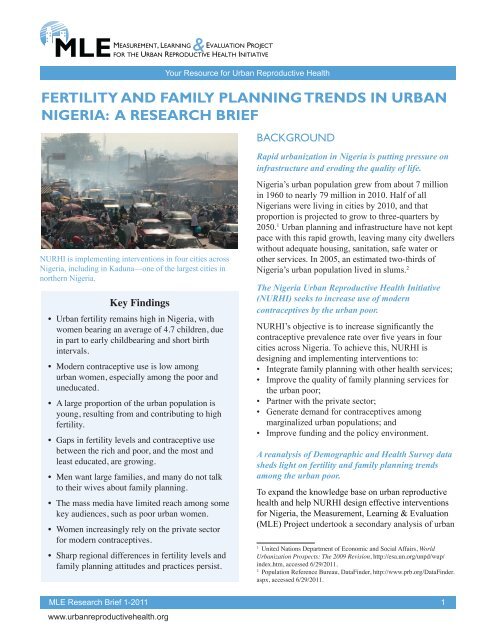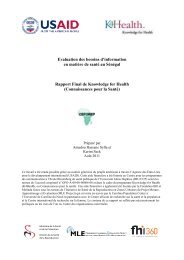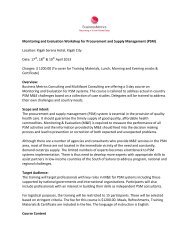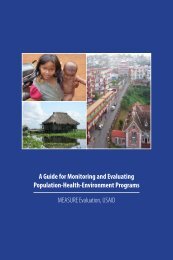fertility and family planning trends in urban nigeria: a research brief
fertility and family planning trends in urban nigeria: a research brief
fertility and family planning trends in urban nigeria: a research brief
You also want an ePaper? Increase the reach of your titles
YUMPU automatically turns print PDFs into web optimized ePapers that Google loves.
Your Resource for Urban Reproductive Health<br />
FERTILITY AND FAMILY PLANNING TRENDS IN URBAN<br />
NIGERIA: A RESEARCH BRIEF<br />
BACKGROUND<br />
Rapid <strong>urban</strong>ization <strong>in</strong> Nigeria is putt<strong>in</strong>g pressure on<br />
<strong>in</strong>frastructure <strong>and</strong> erod<strong>in</strong>g the quality of life.<br />
NURHI is implement<strong>in</strong>g <strong>in</strong>terventions <strong>in</strong> four cities across<br />
Nigeria, <strong>in</strong>clud<strong>in</strong>g <strong>in</strong> Kaduna—one of the largest cities <strong>in</strong><br />
northern Nigeria.<br />
Key F<strong>in</strong>d<strong>in</strong>gs<br />
• Urban <strong>fertility</strong> rema<strong>in</strong>s high <strong>in</strong> Nigeria, with<br />
women bear<strong>in</strong>g an average of 4.7 children, due<br />
<strong>in</strong> part to early childbear<strong>in</strong>g <strong>and</strong> short birth<br />
<strong>in</strong>tervals.<br />
• Modern contraceptive use is low among<br />
<strong>urban</strong> women, especially among the poor <strong>and</strong><br />
uneducated.<br />
• A large proportion of the <strong>urban</strong> population is<br />
young, result<strong>in</strong>g from <strong>and</strong> contribut<strong>in</strong>g to high<br />
<strong>fertility</strong>.<br />
• Gaps <strong>in</strong> <strong>fertility</strong> levels <strong>and</strong> contraceptive use<br />
between the rich <strong>and</strong> poor, <strong>and</strong> the most <strong>and</strong><br />
least educated, are grow<strong>in</strong>g.<br />
• Men want large families, <strong>and</strong> many do not talk<br />
to their wives about <strong>family</strong> <strong>plann<strong>in</strong>g</strong>.<br />
• The mass media have limited reach among some<br />
key audiences, such as poor <strong>urban</strong> women.<br />
• Women <strong>in</strong>creas<strong>in</strong>gly rely on the private sector<br />
for modern contraceptives.<br />
• Sharp regional differences <strong>in</strong> <strong>fertility</strong> levels <strong>and</strong><br />
<strong>family</strong> <strong>plann<strong>in</strong>g</strong> attitudes <strong>and</strong> practices persist.<br />
Nigeria’s <strong>urban</strong> population grew from about 7 million<br />
<strong>in</strong> 1960 to nearly 79 million <strong>in</strong> 2010. Half of all<br />
Nigerians were liv<strong>in</strong>g <strong>in</strong> cities by 2010, <strong>and</strong> that<br />
proportion is projected to grow to three-quarters by<br />
2050. 1 Urban <strong>plann<strong>in</strong>g</strong> <strong>and</strong> <strong>in</strong>frastructure have not kept<br />
pace with this rapid growth, leav<strong>in</strong>g many city dwellers<br />
without adequate hous<strong>in</strong>g, sanitation, safe water or<br />
other services. In 2005, an estimated two-thirds of<br />
Nigeria’s <strong>urban</strong> population lived <strong>in</strong> slums. 2<br />
The Nigeria Urban Reproductive Health Initiative<br />
(NURHI) seeks to <strong>in</strong>crease use of modern<br />
contraceptives by the <strong>urban</strong> poor.<br />
NURHI’s objective is to <strong>in</strong>crease significantly the<br />
contraceptive prevalence rate over five years <strong>in</strong> four<br />
cities across Nigeria. To achieve this, NURHI is<br />
design<strong>in</strong>g <strong>and</strong> implement<strong>in</strong>g <strong>in</strong>terventions to:<br />
• Integrate <strong>family</strong> <strong>plann<strong>in</strong>g</strong> with other health services;<br />
• Improve the quality of <strong>family</strong> <strong>plann<strong>in</strong>g</strong> services for<br />
the <strong>urban</strong> poor;<br />
• Partner with the private sector;<br />
• Generate dem<strong>and</strong> for contraceptives among<br />
marg<strong>in</strong>alized <strong>urban</strong> populations; <strong>and</strong><br />
• Improve fund<strong>in</strong>g <strong>and</strong> the policy environment.<br />
A reanalysis of Demographic <strong>and</strong> Health Survey data<br />
sheds light on <strong>fertility</strong> <strong>and</strong> <strong>family</strong> <strong>plann<strong>in</strong>g</strong> <strong>trends</strong><br />
among the <strong>urban</strong> poor.<br />
To exp<strong>and</strong> the knowledge base on <strong>urban</strong> reproductive<br />
health <strong>and</strong> help NURHI design effective <strong>in</strong>terventions<br />
for Nigeria, the Measurement, Learn<strong>in</strong>g & Evaluation<br />
(MLE) Project undertook a secondary analysis of <strong>urban</strong><br />
1<br />
United Nations Department of Economic <strong>and</strong> Social Affairs, World<br />
Urbanization Prospects: The 2009 Revision, http://esa.un.org/unpd/wup/<br />
<strong>in</strong>dex.htm, accessed 6/29/2011.<br />
2<br />
Population Reference Bureau, DataF<strong>in</strong>der, http://www.prb.org/DataF<strong>in</strong>der.<br />
aspx, accessed 6/29/2011.<br />
MLE Research Brief 1-2011<br />
www.<strong>urban</strong>reproductivehealth.org<br />
1
data from the 1990, 1999 3 , 2003 <strong>and</strong> 2008 rounds of<br />
the Nigeria Demographic <strong>and</strong> Health Survey (NDHS). 4<br />
Data from <strong>urban</strong> survey respondents were recoded<br />
<strong>and</strong> reanalyzed to describe levels <strong>and</strong> <strong>trends</strong> <strong>in</strong> key<br />
<strong>fertility</strong>, <strong>family</strong> <strong>plann<strong>in</strong>g</strong> <strong>and</strong> reproductive health<br />
<strong>in</strong>dicators. The analysis also exam<strong>in</strong>es differentials<br />
by region, household wealth <strong>and</strong> education, although<br />
these variables are <strong>in</strong>ter-related. There is considerable<br />
overlap between the wealthy <strong>and</strong> better educated<br />
groups.<br />
Figure 1. TFR <strong>in</strong> <strong>urban</strong> areas, by region, 2008<br />
TFR <strong>in</strong> <strong>urban</strong> areas, by region, 2008 NDHS<br />
South West<br />
South South<br />
South East<br />
North West<br />
North East<br />
North Central<br />
All <strong>urban</strong> areas<br />
0 1 2 3 4 5 6 7 8<br />
TFR<br />
A large proportion of the <strong>urban</strong> population is young.<br />
Over 40 percent of the <strong>urban</strong> population <strong>in</strong> Nigeria is<br />
less than 15 years old, while only 4 percent is aged<br />
65 or older. This young population structure results<br />
from <strong>and</strong> contributes to cont<strong>in</strong>ued high <strong>fertility</strong>. The<br />
high ratio of dependents to workers stra<strong>in</strong>s the ability<br />
of cities to meet residents’ essential needs, <strong>in</strong>clud<strong>in</strong>g<br />
health, education, food <strong>and</strong> shelter.<br />
There is a widen<strong>in</strong>g gap between the rich <strong>and</strong> poor,<br />
<strong>and</strong> the more <strong>and</strong> less educated.<br />
In Ibadan, Nigeria, young people comprise a large<br />
proportion of the city’s population.<br />
HOW HIGH IS FERTILITY IN NIGERIAN<br />
CITIES?<br />
Fertility rema<strong>in</strong>s high <strong>in</strong> <strong>urban</strong> Nigeria, especially <strong>in</strong><br />
the north.<br />
Over the past two decades, <strong>fertility</strong> levels have changed<br />
little, decl<strong>in</strong><strong>in</strong>g only from 5.1 children <strong>in</strong> 1990 to 4.7<br />
children <strong>in</strong> 2008. Women <strong>in</strong> the North East <strong>and</strong> North<br />
West have 2 more children, on average, than women <strong>in</strong><br />
other regions of the country (Figure 1).<br />
3<br />
Because the 1999 survey was collected with limited technical assistance<br />
from the DHS program, data from 1999 may not be directly comparable to<br />
data from other years.<br />
4<br />
This <strong>research</strong> <strong>brief</strong> summarizes <strong>family</strong> <strong>plann<strong>in</strong>g</strong> <strong>and</strong> <strong>fertility</strong> data from<br />
the MLE’s reanalysis of NDHS data. For the full paper, see Jean Christophe<br />
Fotso et al., “Family Plann<strong>in</strong>g <strong>and</strong> Reproductive Health <strong>in</strong> Urban Nigeria:<br />
Levels, Trends <strong>and</strong> Differentials,” MLE Technical Work<strong>in</strong>g Paper 2-2010<br />
(January 2011). http://www.<strong>urban</strong>reproductivehealth.org/system/files/<br />
F<strong>in</strong>al%20<strong>nigeria</strong>%20twp%201-27-11.pdf<br />
TFR<br />
The burden of high <strong>fertility</strong> <strong>and</strong> its associated health<br />
risks falls more heavily on the poor <strong>and</strong> less educated.<br />
From 1990 to 2008, <strong>fertility</strong> rose <strong>in</strong> poor <strong>urban</strong><br />
households by over 9 percent, while fall<strong>in</strong>g by about 10<br />
percent <strong>in</strong> rich <strong>and</strong> middle-<strong>in</strong>come households<br />
(Figure 2). 5 Trends by education followed a similar<br />
pattern. By 2008, the <strong>urban</strong> poor had 2.2 more children,<br />
on average, than the rich; women with no education<br />
had 3.1 more children than those with secondary or<br />
higher education.<br />
Figure 2. Trend <strong>in</strong> <strong>urban</strong> TFR, by household wealth<br />
Trend <strong>in</strong> <strong>urban</strong> TFR, by household wealth<br />
7<br />
6<br />
5<br />
4<br />
3<br />
2<br />
Poor Middle Rich<br />
1990 1999 2003 2008<br />
5<br />
The analysis divided the population <strong>in</strong>to three equal groups (or tertiles)<br />
by household wealth. All data on the <strong>urban</strong> poor describe the bottom tertile,<br />
while data on the rich describe the top tertile.<br />
MLE Research Brief 1-2011 2<br />
www.<strong>urban</strong>reproductivehealth.org
Early childbear<strong>in</strong>g, particularly among the <strong>urban</strong><br />
poor, <strong>and</strong> short birth <strong>in</strong>tervals contribute to high<br />
<strong>fertility</strong>.<br />
Adolescent childbear<strong>in</strong>g <strong>and</strong> short birth <strong>in</strong>tervals<br />
<strong>in</strong>crease health risks for mothers <strong>and</strong> children. The<br />
proportion of <strong>urban</strong> teenagers who were pregnant or<br />
mothers decl<strong>in</strong>ed from 17.4 percent <strong>in</strong> 1990 to 12.0<br />
percent <strong>in</strong> 2008, but teen pregnancy rates rema<strong>in</strong> high<br />
among the poor <strong>and</strong> uneducated (Figure 3). In 2008,<br />
23% of poor <strong>urban</strong> teenagers were pregnant or mothers<br />
compared with 4% of rich <strong>urban</strong> teenagers. Teenagers<br />
with no education are 7.8 times more likely to become<br />
mothers than those with secondary or higher education.<br />
Figure 3. Percent of <strong>urban</strong> teenagers who were<br />
Percent of <strong>urban</strong> teenagers who were<br />
pregnant or mothers, by wealth <strong>and</strong> education<br />
Percent<br />
60<br />
50<br />
40<br />
30<br />
20<br />
10<br />
0<br />
Poor<br />
pregnant or mothers, by wealth <strong>and</strong> education<br />
Middle<br />
Rich<br />
1990 2008<br />
No education<br />
Primary<br />
Secondary<br />
HOW COMMON IS USE OF MODERN<br />
CONTRACEPTIVE METHODS?<br />
Modern contraceptive use is especially low among poor<br />
<strong>and</strong> uneducated women <strong>and</strong> <strong>in</strong> parts of the north.<br />
Overall, modern contraceptive use 6 rose from 9.6<br />
percent of <strong>urban</strong> women <strong>in</strong> 1990 to 16.7 percent <strong>in</strong><br />
2008. However, ga<strong>in</strong>s were much smaller among poor<br />
households (Figure 4) <strong>and</strong> women with no education.<br />
Only 7 percent of poor women <strong>and</strong> 5 percent of<br />
uneducated women used a modern method <strong>in</strong> 2008.<br />
Rich women are 3.5 times more likely to use a modern<br />
method than poor women.<br />
Percent of <strong>urban</strong> women currently us<strong>in</strong>g modern<br />
contraception, by household wealth<br />
Less than 7 percent of women <strong>in</strong> the North East<br />
<strong>and</strong> North West use modern contraception. Women<br />
elsewhere are two to four times more likely to use a<br />
modern method.<br />
Figure 4. Percent of <strong>urban</strong> women currently us<strong>in</strong>g<br />
modern contraception, by household wealth<br />
In Ilor<strong>in</strong>, Nigeria, young mothers <strong>and</strong> their babies wait to<br />
receive health services.<br />
Percent<br />
30<br />
25<br />
20<br />
15<br />
10<br />
5<br />
0<br />
Poor Middle Rich<br />
1990 1999 2003 2008<br />
Almost one <strong>in</strong> four births <strong>in</strong> Nigerian cities is preceded<br />
by a short birth <strong>in</strong>terval (less than two years), <strong>and</strong> there<br />
has been little change over the past two decades.<br />
6<br />
In all four surveys, modern contraceptives <strong>in</strong>cluded the follow<strong>in</strong>g methods:<br />
female <strong>and</strong> male sterilization, oral contraceptive pills, <strong>in</strong>trauter<strong>in</strong>e devices<br />
(IUDs), <strong>in</strong>jectables, implants, male condoms, diaphragms, foam <strong>and</strong> jelly.<br />
The 2003 <strong>and</strong> 2008 surveys added three additional modern methods:<br />
female condoms, Lactational Amenorrhea Method (LAM) <strong>and</strong> emergency<br />
contraception.<br />
MLE Research Brief 1-2011<br />
www.<strong>urban</strong>reproductivehealth.org<br />
3
Urban women <strong>in</strong>creas<strong>in</strong>gly use contraceptive methods<br />
to space births.<br />
The percentage of married <strong>urban</strong> women who adopt<br />
contraception when they have just one or two children<br />
doubled from 1990 to 2008 (Figure 5), which suggests<br />
that they are us<strong>in</strong>g contraception to space births.<br />
Because couples want large families, few births are<br />
considered mistimed or unwanted. In 2008, <strong>urban</strong><br />
women reported that 4.9 percent of births <strong>in</strong> the<br />
preced<strong>in</strong>g five years were not wanted, while 6.8<br />
percent were mistimed. As a result, there is little<br />
perceived need for <strong>family</strong> <strong>plann<strong>in</strong>g</strong>.<br />
Women Percent are two distribution to four of times currently more married likely <strong>urban</strong> to adopt<br />
contraceptive<br />
women by<br />
methods<br />
parity at first<br />
at lower<br />
contraceptive<br />
parities<br />
use<br />
if they come<br />
from rich rather than poor households, have secondary<br />
or higher education rather than no education or live <strong>in</strong><br />
the south rather than the north.<br />
Figure 5. Percent distribution of currently married<br />
<strong>urban</strong> women, by parity at first contraceptive use<br />
No children 1-2 children 3+ children<br />
Percent<br />
25<br />
20<br />
15<br />
10<br />
5<br />
0<br />
1990 1999 2003 2008<br />
WHAT ARE CURRENT ATTITUDES<br />
TOWARD FERTILITY AND FAMILY<br />
PLANNING?<br />
Urban women <strong>and</strong> men, especially the poor <strong>and</strong> less<br />
educated, still want large families.<br />
In 2008, <strong>urban</strong> women preferred to have 5.2 children,<br />
on average, while men preferred 5.8 children. This is<br />
Ideal number of children for <strong>urban</strong> women <strong>and</strong><br />
a decrease men, from by household 6.0 <strong>and</strong> 6.6 wealth, children, 2008 NDHS respectively, <strong>in</strong><br />
2003. Desired <strong>family</strong> size decreases with wealth <strong>and</strong><br />
education. Poor <strong>urban</strong> women <strong>and</strong> men want 2.3 <strong>and</strong><br />
3.9 more children, respectively, than the rich (Figure 6).<br />
Number<br />
Figure 6. Ideal number of children for <strong>urban</strong> women<br />
<strong>and</strong> men, by household wealth, 2008<br />
10<br />
8<br />
6<br />
4<br />
2<br />
0<br />
Women<br />
Men<br />
Poor Middle Rich<br />
A service provider counsels a client about reproductive<br />
health issues<br />
Less than two-fifths of the <strong>urban</strong> poor approve of<br />
us<strong>in</strong>g contraceptive methods.<br />
Widespread disapproval of <strong>family</strong> <strong>plann<strong>in</strong>g</strong> can act<br />
as a barrier to contraceptive use. The percentage<br />
of <strong>urban</strong> residents who approve of couples us<strong>in</strong>g<br />
contraception has been decl<strong>in</strong><strong>in</strong>g <strong>in</strong> Nigeria: from<br />
77.5 percent <strong>in</strong> 1990 to 60.3 percent <strong>in</strong> 2003 among<br />
women, <strong>and</strong> from 66.9 percent <strong>in</strong> 1999 to 58.1<br />
percent <strong>in</strong> 2003 Percent among of <strong>urban</strong> men. women 7 The <strong>urban</strong> <strong>and</strong> men rich who were<br />
twice as likely to approve of contraceptive of use, use as the<br />
poor <strong>in</strong> 2003, by the household last year for wealth, which 2003 there NDHS is DHS<br />
data (Figure 7). Differentials were even greater by<br />
education <strong>and</strong> region.<br />
Percent<br />
Figure 7. Percent of <strong>urban</strong> women <strong>and</strong> men who<br />
approve of contraceptive use, by household wealth,<br />
2003<br />
100<br />
80<br />
60<br />
40<br />
20<br />
0<br />
Women<br />
Men<br />
Poor Middle Rich<br />
7<br />
The 2008 NDHS did not ask respondents whether they approved of<br />
us<strong>in</strong>g contraceptive methods, so the data from 2003 is the most recent<br />
available.<br />
MLE Research Brief 1-2011 4<br />
www.<strong>urban</strong>reproductivehealth.org
contraceptives from the private sector, by<br />
household wealth<br />
Many <strong>urban</strong> women, especially the poor <strong>and</strong><br />
uneducated, do not <strong>in</strong>tend to use contraceptives <strong>in</strong> the<br />
future.<br />
Among <strong>urban</strong> women who are not currently us<strong>in</strong>g<br />
a contraceptive method, the proportion who do not<br />
<strong>in</strong>tend to use contraception <strong>in</strong> the future rose from<br />
53.3 percent <strong>in</strong> 1990 to 60.5 percent <strong>in</strong> 2003, before<br />
decl<strong>in</strong><strong>in</strong>g to 46.8 percent <strong>in</strong> 2008. From half to twothirds<br />
of poor women, uneducated women, <strong>and</strong> women<br />
liv<strong>in</strong>g <strong>in</strong> the North East <strong>and</strong> North West do not <strong>in</strong>tend<br />
to use contraception <strong>in</strong> the future.<br />
WHERE DO WOMEN OBTAIN<br />
CONTRACEPTIVE SUPPLIES?<br />
Women, <strong>in</strong>clud<strong>in</strong>g the <strong>urban</strong> poor, <strong>in</strong>creas<strong>in</strong>gly rely<br />
on the private sector for modern contraceptives.<br />
The private sector has the potential to <strong>in</strong>crease<br />
coverage of reproductive health services, especially for<br />
women who cannot or choose not to access government<br />
services. The proportion of <strong>urban</strong> women obta<strong>in</strong><strong>in</strong>g<br />
modern contraceptives from the private sector,<br />
<strong>in</strong>clud<strong>in</strong>g private hospitals/cl<strong>in</strong>ics, pharmacies, patent<br />
medical stores, <strong>and</strong> doctors, rose from 45.5 percent<br />
<strong>in</strong> 1990 to 60.7 percent <strong>in</strong> 2008. Although privatesector<br />
sources are more important for middle-<strong>in</strong>come<br />
<strong>and</strong> rich women, over half of the <strong>urban</strong> poor obta<strong>in</strong><br />
contraceptives from the private sector (Figure 8).<br />
Percent<br />
Figure 8. Percent of <strong>urban</strong> women obta<strong>in</strong><strong>in</strong>g<br />
modern contraceptives from the private sector, by<br />
household wealth<br />
80<br />
70<br />
60<br />
50<br />
40<br />
30<br />
20<br />
10<br />
0<br />
Poor Middle Rich<br />
1990 1999 2003 2008<br />
Women<br />
Percent<br />
<strong>in</strong> the south<br />
of <strong>urban</strong><br />
are<br />
women<br />
twice as<br />
obta<strong>in</strong><strong>in</strong>g<br />
likely as<br />
modern<br />
those <strong>in</strong><br />
the north contraceptives to obta<strong>in</strong> modern from contraceptives the private sector from the<br />
private sector.<br />
Reliance on the private sector has <strong>in</strong>creased <strong>in</strong> every<br />
region s<strong>in</strong>ce 1990 (Figure 9). In 2008, about 6 or 7<br />
<strong>family</strong> <strong>plann<strong>in</strong>g</strong> users <strong>in</strong> 10 relied on the private sector<br />
for contraceptive supplies <strong>in</strong> the south, compared with<br />
just 3 or 4 <strong>family</strong> <strong>plann<strong>in</strong>g</strong> users <strong>in</strong> 10 <strong>in</strong> the north.<br />
Figure 9. Percent of <strong>urban</strong> women obta<strong>in</strong><strong>in</strong>g<br />
modern contraceptives from the private sector<br />
1990<br />
2008<br />
South West<br />
South South<br />
South East<br />
North West<br />
North East<br />
North Central<br />
0 10 20 30 40 50 60 70 80<br />
Percent<br />
A <strong>family</strong> <strong>plann<strong>in</strong>g</strong> poster <strong>in</strong> a health care facility <strong>in</strong> the<br />
city of Kaduna illustrates the need for new communication<br />
strategies.<br />
MLE Research Brief 1-2011<br />
www.<strong>urban</strong>reproductivehealth.org<br />
5
HOW WIDELY DO THE MASS<br />
MEDIA SPREAD FAMILY PLANNING<br />
MESSAGES?<br />
Radio <strong>and</strong> television are the two most common<br />
media sources of <strong>family</strong> <strong>plann<strong>in</strong>g</strong> messages.<br />
The mass media are a powerful way to convey <strong>family</strong><br />
<strong>plann<strong>in</strong>g</strong> messages to the public <strong>and</strong> can help change<br />
social norms <strong>and</strong> facilitate behavior change. While<br />
radio ownership has rema<strong>in</strong>ed stable at about fourfifths<br />
of <strong>urban</strong> households, television ownership grew<br />
from 57.1 percent <strong>in</strong> 1990 to 69.0 percent <strong>in</strong> 2008.<br />
Televisions are primarily located <strong>in</strong> the south; radios<br />
have even geographic distribution.<br />
Radio <strong>and</strong> television are the most common media<br />
sources of <strong>family</strong> <strong>plann<strong>in</strong>g</strong> messages for <strong>urban</strong><br />
residents <strong>in</strong> Nigeria, regardless of sex, age, education,<br />
household wealth <strong>and</strong> region (see Figure 10 for data<br />
by sex).<br />
Percent<br />
Figure 10. Percent of <strong>urban</strong> women <strong>and</strong> men<br />
exposed to <strong>family</strong> <strong>plann<strong>in</strong>g</strong> messages <strong>in</strong> the mass<br />
media, 2008<br />
80<br />
70<br />
60<br />
50<br />
40<br />
30<br />
20<br />
10<br />
0<br />
Women<br />
Men<br />
Radio Television Newspapers None of these<br />
Men have greater exposure to the mass media than<br />
women.<br />
Men are more likely than women to have heard or<br />
seen a <strong>family</strong> <strong>plann<strong>in</strong>g</strong> message on radio, television<br />
<strong>and</strong> newspapers (Figure 10). Women are 1.5 times<br />
more likely than men to have no exposure at all to<br />
<strong>family</strong> <strong>plann<strong>in</strong>g</strong> messages <strong>in</strong> any of these media.<br />
Exposure to mass media <strong>in</strong>creases with wealth <strong>and</strong><br />
education.<br />
Percent of <strong>urban</strong> women exposed to <strong>family</strong><br />
Rich <strong>urban</strong> plannn<strong>in</strong>g women messages are more <strong>in</strong> likely the mass than media, the poor by<br />
to have heard household or seen <strong>family</strong> wealth, <strong>plann<strong>in</strong>g</strong> 2008 NDHS messages<br />
on radio, television <strong>and</strong> newspapers (Figure 11).<br />
Exposure to <strong>family</strong> <strong>plann<strong>in</strong>g</strong> messages <strong>in</strong> the mass<br />
media also <strong>in</strong>creases with education. Radio reached<br />
2.4 times as many poor households as television <strong>and</strong><br />
7.8 times as many households as newspapers <strong>in</strong> 2008.<br />
Figure 11. Percent of <strong>urban</strong> women exposed to<br />
<strong>family</strong> plannn<strong>in</strong>g messages <strong>in</strong> the mass media, by<br />
household wealth, 2008<br />
80<br />
Poor Middle Rich<br />
The new “Get it Together” <strong>family</strong> <strong>plann<strong>in</strong>g</strong> campaign<br />
from NURHI encourages people to get <strong>in</strong>formation,<br />
have conversations, <strong>and</strong> get a method.<br />
Percent<br />
70<br />
60<br />
50<br />
40<br />
30<br />
20<br />
10<br />
0<br />
Radio Television Newspapers None of these<br />
MLE Research Brief 1-2011 6<br />
www.<strong>urban</strong>reproductivehealth.org
Most of the <strong>urban</strong> poor <strong>and</strong> most women who live <strong>in</strong><br />
northern cities are not exposed to <strong>family</strong> <strong>plann<strong>in</strong>g</strong><br />
messages <strong>in</strong> the mass media.<br />
In <strong>urban</strong> areas, almost two-thirds of poor women did<br />
not hear, see or read <strong>family</strong> <strong>plann<strong>in</strong>g</strong> messages <strong>in</strong><br />
any of the mass media (Figure 11). Similarly, most<br />
<strong>urban</strong> women <strong>in</strong> the north were not exposed to <strong>family</strong><br />
<strong>plann<strong>in</strong>g</strong> messages <strong>in</strong> any media (Figure 12).<br />
Figure Percent 12. Percent of <strong>urban</strong> of women <strong>urban</strong> who women were who NOT were exposed NOT<br />
exposed<br />
to any <strong>family</strong> <strong>plann<strong>in</strong>g</strong><br />
<strong>plann<strong>in</strong>g</strong><br />
messages<br />
messages<br />
<strong>in</strong><br />
<strong>in</strong><br />
radio,<br />
radio,<br />
television or newspapers, by region, 2008 NDHS<br />
television or newspapers, by region, 2008<br />
South West<br />
South South<br />
South East<br />
North West<br />
North East<br />
North Central<br />
0 10 20 30 40 50 60 70 80<br />
Percent<br />
HOW LIKELY ARE COUPLES TO<br />
DISCUSS FAMILY PLANNING?<br />
Discussion of <strong>family</strong> <strong>plann<strong>in</strong>g</strong> among <strong>urban</strong> couples<br />
decl<strong>in</strong>ed from 1990 to 2003, the period for which data<br />
are available.<br />
Couple communication about <strong>family</strong> <strong>plann<strong>in</strong>g</strong> is an<br />
important step on the path to adopt<strong>in</strong>g a contraceptive<br />
method. In <strong>urban</strong> areas, the proportion of married<br />
women who had discussed <strong>family</strong> <strong>plann<strong>in</strong>g</strong> with their<br />
husb<strong>and</strong>s <strong>in</strong> the past year rose from 49.5 percent <strong>in</strong><br />
1990 to 54.5 percent <strong>in</strong> 1999, but then decl<strong>in</strong>ed to 43.3<br />
percent <strong>in</strong> 2003, the last year for which there is DHS<br />
data.<br />
Less than 30 percent of married teenaged women<br />
<strong>in</strong> <strong>urban</strong> areas reported discuss<strong>in</strong>g <strong>family</strong> <strong>plann<strong>in</strong>g</strong><br />
with their husb<strong>and</strong>s <strong>in</strong> 2003, compared with about 45<br />
percent of older women.<br />
Percent of married <strong>urban</strong> women who discussed<br />
Figure <strong>family</strong> 13. Percent <strong>plann<strong>in</strong>g</strong> of with married their spouse <strong>urban</strong> <strong>in</strong> the women past year, who<br />
discussed <strong>family</strong> <strong>plann<strong>in</strong>g</strong> by household with wealth their spouse <strong>in</strong> the<br />
past year, by household wealth<br />
Percent<br />
70<br />
60<br />
50<br />
40<br />
30<br />
20<br />
10<br />
0<br />
Poor Middle Rich<br />
1990 1999 2003<br />
Couple communication regard<strong>in</strong>g <strong>family</strong> <strong>plann<strong>in</strong>g</strong> is<br />
more common <strong>in</strong> parts of the south.<br />
Married <strong>urban</strong> women were considerably more likely<br />
to discuss <strong>family</strong> <strong>plann<strong>in</strong>g</strong> with their husb<strong>and</strong>s <strong>in</strong> the<br />
South West <strong>and</strong> South South than <strong>in</strong> other regions<br />
(Figure 14).<br />
Figure <strong>family</strong> 14. <strong>plann<strong>in</strong>g</strong> Percent with of married their spouse, <strong>urban</strong> by region, women 2003 who<br />
discussed <strong>family</strong> <strong>plann<strong>in</strong>g</strong> NDHS with their spouse, by<br />
region, 2003<br />
South West<br />
South South<br />
South East<br />
North West<br />
North East<br />
North Central<br />
Percent of married <strong>urban</strong> women who discussed<br />
0 10 20 30 40 50 60 70<br />
Percent<br />
Poor, uneducated <strong>and</strong> teenaged women are less likely<br />
than others to discuss <strong>family</strong> <strong>plann<strong>in</strong>g</strong> with their<br />
husb<strong>and</strong>s.<br />
In 2003, only one <strong>in</strong> four poor or uneducated <strong>urban</strong><br />
women reported discuss<strong>in</strong>g <strong>family</strong> <strong>plann<strong>in</strong>g</strong> with<br />
their husb<strong>and</strong>s. More than twice as many rich women<br />
(Figure 13) <strong>and</strong> highly educated women had done so.<br />
MLE Research Brief 1-2011<br />
www.<strong>urban</strong>reproductivehealth.org<br />
7
SUMMARY<br />
Urban <strong>fertility</strong> rema<strong>in</strong>s high, due <strong>in</strong> part to early<br />
childbear<strong>in</strong>g <strong>and</strong> short birth <strong>in</strong>tervals.<br />
Fertility <strong>in</strong> <strong>urban</strong> Nigeria has decl<strong>in</strong>ed slightly s<strong>in</strong>ce<br />
1990, but women still bear an average of 4.7 children.<br />
Teen pregnancies rema<strong>in</strong> common among the poor <strong>and</strong><br />
uneducated, despite a drop <strong>in</strong> overall teen pregnancy<br />
rates. There has been little change <strong>in</strong> birth spac<strong>in</strong>g:<br />
almost one <strong>in</strong> four births follows an <strong>in</strong>terval of less<br />
than two years.<br />
Because desired <strong>family</strong> size is high, contraceptive use<br />
rema<strong>in</strong>s low.<br />
There has been a small rise <strong>in</strong> modern contraceptive<br />
use s<strong>in</strong>ce 1990, but less than 7 percent of poor <strong>and</strong><br />
uneducated women use a modern method. A traditional<br />
preference for large families is the lead<strong>in</strong>g reason<br />
women do not use contraception. Most poor <strong>and</strong><br />
uneducated women do not <strong>in</strong>tend to use contraception<br />
<strong>in</strong> the future. However, there is grow<strong>in</strong>g <strong>in</strong>terest <strong>in</strong><br />
us<strong>in</strong>g modern methods to space births among wealthy<br />
<strong>and</strong> more educated women.<br />
A large proportion of the <strong>urban</strong> population is young,<br />
result<strong>in</strong>g from <strong>and</strong> contribut<strong>in</strong>g to high <strong>fertility</strong>.<br />
Over 40 percent of the <strong>urban</strong> population <strong>in</strong> Nigeria is<br />
less than 15 years old, while only 4 percent is aged<br />
65 or older. The high ratio of dependents to workers<br />
stra<strong>in</strong>s the ability of cities to meet residents’ essential<br />
needs, <strong>in</strong>clud<strong>in</strong>g health, education, food <strong>and</strong> shelter.<br />
Gaps <strong>in</strong> <strong>fertility</strong> <strong>and</strong> contraceptive use between the<br />
rich <strong>and</strong> poor, <strong>and</strong> the most <strong>and</strong> least educated, are<br />
grow<strong>in</strong>g.<br />
Over the last two decades, wealthy <strong>and</strong> well educated<br />
city dwellers have become more supportive of <strong>family</strong><br />
<strong>plann<strong>in</strong>g</strong>, <strong>and</strong> their <strong>fertility</strong> rate has dropped. Trends<br />
have moved <strong>in</strong> the opposite direction for the <strong>urban</strong> poor<br />
<strong>and</strong> those with no education.<br />
Male <strong>in</strong>volvement <strong>in</strong> <strong>family</strong> <strong>plann<strong>in</strong>g</strong> is limited.<br />
Men are more likely than women to see or hear <strong>family</strong><br />
<strong>plann<strong>in</strong>g</strong> messages <strong>in</strong> the mass media. However, <strong>urban</strong><br />
men—especially poor men—want even larger families<br />
than women do. Most poor <strong>and</strong> uneducated couples<br />
have not discussed <strong>family</strong> <strong>plann<strong>in</strong>g</strong> <strong>in</strong> the past year.<br />
The mass media have limited reach among some key<br />
audiences.<br />
Radio is the most common media source of <strong>family</strong><br />
<strong>plann<strong>in</strong>g</strong> messages <strong>in</strong> <strong>urban</strong> Nigeria. However, it<br />
reaches less than two-fifths of poor <strong>urban</strong> women <strong>and</strong><br />
less than half of <strong>urban</strong> women <strong>in</strong> the north.<br />
Women, <strong>in</strong>clud<strong>in</strong>g the <strong>urban</strong> poor, <strong>in</strong>creas<strong>in</strong>gly rely<br />
on the private sector for modern contraceptives.<br />
Over the past two decades, the proportion of women<br />
who obta<strong>in</strong> modern contraceptives from the private<br />
sector has <strong>in</strong>creased <strong>in</strong> every region of the country.<br />
Today the majority of <strong>urban</strong> women—<strong>in</strong>clud<strong>in</strong>g poor<br />
women—rely on the private sector for contraceptive<br />
supplies.<br />
Sharp regional differences <strong>in</strong> attitudes <strong>and</strong> practices<br />
about <strong>family</strong> <strong>plann<strong>in</strong>g</strong> <strong>and</strong> contraceptive use persist.<br />
There is a substantial gap between north <strong>and</strong> south on<br />
most <strong>in</strong>dicators. Fertility rates are markedly higher<br />
<strong>in</strong> some areas of the north, while approval <strong>and</strong> use<br />
of <strong>family</strong> <strong>plann<strong>in</strong>g</strong> methods are lower. Women <strong>in</strong><br />
the north are also less likely to rely on private sector<br />
sources for modern contraceptives or to see or hear<br />
<strong>family</strong> <strong>plann<strong>in</strong>g</strong> messages <strong>in</strong> the mass media.<br />
For more detailed <strong>in</strong>formation about the NURHI study<br />
cities, see the “2010-2011 Nigeria Basel<strong>in</strong>e Survey for<br />
the Urban Reproductive Health Initiative” report at www.<br />
nurhi.org/sites/nurhi.k4health.org/files/2011_Nigeria_<br />
Urban_Reproductive_Health_Survey_FINAL.pdf.<br />
For more <strong>in</strong>formation about <strong>urban</strong> reproductive health, please visit www.<strong>urban</strong>reproductivehealth.org.<br />
This fact sheet was made possible by support from the Bill & Mel<strong>in</strong>da Gates Foundation under terms of the MLE project for the<br />
Urban Reproductive Health Initiative. The MLE project is implemented by the Carol<strong>in</strong>a Population Center at the University of<br />
North Carol<strong>in</strong>a at Chapel Hill, <strong>in</strong> partnership with the African Population <strong>and</strong> Health Research Center <strong>and</strong> the International Center<br />
for Research on Women. The authors’ views expressed <strong>in</strong> this publication do not necessarily reflect the views of the donor.<br />
MLE Research Brief 1-2011 8<br />
www.<strong>urban</strong>reproductivehealth.org<br />
Photos: © 2011 Bonnie Gillespie














![questionnaire no: [__|__|__|__|__|__|__|__|__] - Measurement ...](https://img.yumpu.com/22729956/1/184x260/questionnaire-no-measurement-.jpg?quality=85)
![questionnaire serial no:[__|__|__|__] - Your Resource for Urban ...](https://img.yumpu.com/10870216/1/184x260/questionnaire-serial-no-your-resource-for-urban-.jpg?quality=85)